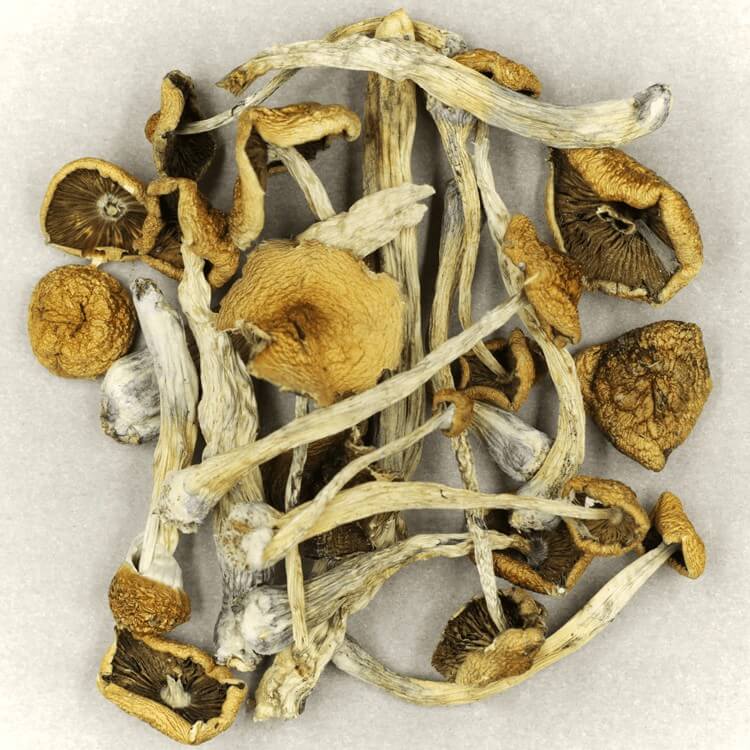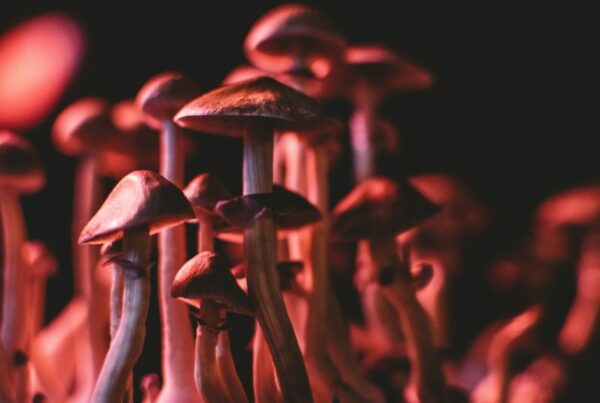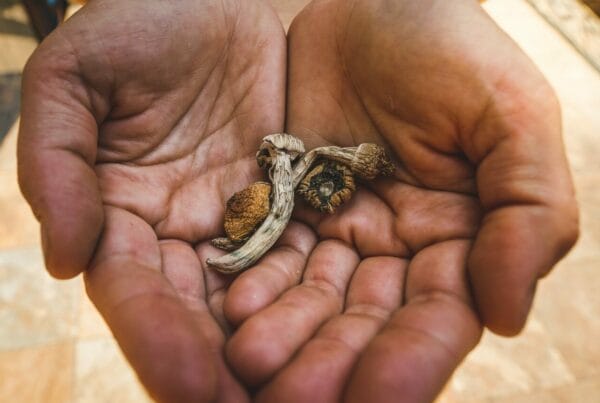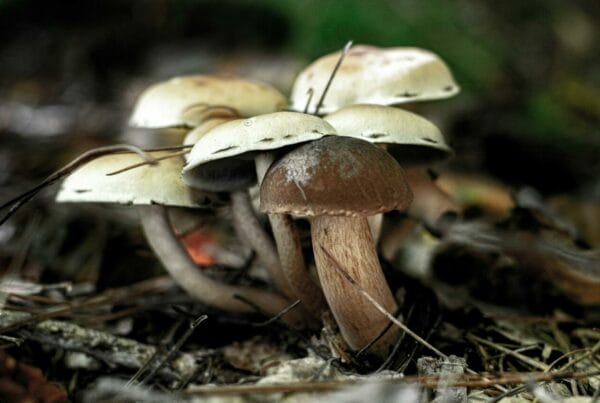Once thought to be purely fantastical, the power of the Psilocybe mexicana mushroom is now increasingly recognized. This shift in perception is largely due to ongoing psilocybin research. The psychedelic research community consistently uncovers its therapeutic benefits, leading to a slow but steady acceptance in the medical world. This emerging field is seen as promising by experts who are working incessantly to establish safe dosage levels for therapeutic use.
Key Takeaways
- Researchers have employed innovative techniques such as liquid chromatography and tandem mass spectrometry to ascertain mushroom potency.
- Psilocybe Mexicana, along with other types of mushrooms, is currently being examined in clinical trials to evaluate its potential therapeutic applications.
- Recognizing the genetic diversity in magic mushrooms is crucial for devising an accurate dosage guide.
Psychedelic Mushrooms: Journey from Obscurity to Groundbreaking Research
Previously, the therapeutic benefits of Psilocybe Cubensis were known for only a few conditions. However, psilocybin is now making considerable progress in uncovering its hidden medicinal capabilities.
Researchers are exploring the potential of Psilocybe Mexicana and other strong strains through clinical trials and exhaustive research. Whether the subjects are in vivo or in vitro, this strain is instrumental in revealing the true effects and benefits of the fungus species.
Psychedelics Making their Way into the Market
Once shrouded in mystery, the continuous discoveries and advancements in the field of psychedelics are captivating public interest, especially those seeking therapeutic remedies. Traditional mental health treatments often prove inadequate, prompting people to explore more effective alternatives.
Enter the world of magic mushrooms.
Patients battling mental health problems are turning to psilocybin, which has demonstrated potential in treating ailments like depression, alcohol addiction, anxiety, compulsions, tics, chronic pain, and more.
Currently, medical professionals are investigating innovative ways to determine the optimal dosage for safe patient administration. A research team from the University of Texas has notably developed a model to extract psilocybin and psilocin concentrations.
Establishing the clinical potency of magic mushrooms is indeed possible.
Mexicana’s Distinctive Traits
Golden Teachers, Blue Meanies, and B-Plus are some of the magic mushroom species that have undergone extensive research. However, to further enhance our knowledge on the safe use of these fungi, researchers need to study other species as well.
The Mexicana species has gained popularity in scientific research, not merely because it’s one of the oldest species, but also because its relatively low potency increases its likelihood of meeting medical drug standards.
Even though the Mexicana species is less potent compared to other magic mushrooms, it can still produce effects similar to mainstream strains. Consequently, as microdosing continues to gain popularity among patients, the Mexicana species becomes a particularly appealing choice.
With consistent psilocybin and psilocin levels comparable to other strains, you might wonder why one should choose the Mexicana species over its counterparts. The answer lies in its historical and anthropological importance.
Delving into the Rich History of the “Mexican” Species
Historically, the Psilocybe Mexicana grew naturally in moss. Indigenous communities held these psilocybin mushrooms in high esteem, often using them in practices linked to mystical or supernatural events.
Now, let’s focus on the Mexican mushrooms. Over two millennia ago, the indigenous people of North and Central America first used these mushrooms, and the Aztecs, an ancient ethnic group, referred to them as “food of the Gods,” or “teonanácatl” in their native language.
If the Aztecs were around today, they would affirm the transformative, emotionally profound, and mentally stabilizing effects of the Mexicana, even without understanding these contemporary terminologies.
Despite varying cultivation techniques, the Mexicana mushroom has retained its natural psilocybin levels, bearing testimony to its authenticity. This authenticity is a recognized standard greatly valued by researchers and psychedelic study institutions.
Innovative Methods for Testing Psilocybin Content and Potency
A team of ten researchers from the University of Texas at Arlington and various other research institutions have devised a novel method to test the potency of psychoactive compounds in mushrooms. This innovative measurement technique integrates liquid chromatography and tandem mass spectrometry.
Here are two groundbreaking techniques:
- Liquid chromatography is a technique used to separate and analyze mixtures of chemicals. It involves passing a liquid sample through a column filled with a solid material, or stationary phase. Various chemicals within the sample interact differently with the stationary and mobile phases, leading to their separation at different rates as they traverse the column. This method is used here to study active chemicals in mushrooms.
- Spectrometry focuses on the interaction of matter with electromagnetic radiation across a spectrum of wavelengths. It identifies and quantifies substances based on the specific wavelengths of light that molecules absorb and reflect. This allows for the assessment of the electronic, vibrational, and rotational states of a chemical.
The researchers utilized these techniques on five different strains of magic mushrooms and discovered that the average total levels of psilocybin and psilocin ranged from 0.879 to 1.36. These concentrations exceeded those found in many other strains, such as Bull Run and Cambodian. The accuracy of their study was affirmed by comparing their results to those obtained from independent labs.
The consistency of the results between the two labs strengthens the validity of their testing procedure to accurately gauge the potency of the mushrooms.
If validated by experts, these methods could add to the existing array of techniques used to test psychedelic strength, thereby acting as an extra safety precaution to prevent incorrect dosage determinations.
Expanding Research to Additional Species
It is advantageous to broaden research to include other species. This could improve our knowledge of the health benefits tied to different strains and provide initial data on the effects of less potent mushrooms.
Moreover, it can help educate individuals about the influence of different dosages on the psychedelic experience. By comparing strains like Mexicans to more potent ones such as Psilocybe Cubensis, researchers can understand how varying concentrations of active compounds can affect therapeutic results.
Take, for example, the Blue Meanies strain. It yields stronger hallucinogenic effects, which could be potentially useful in treating conditions like depression. In contrast, less potent strains are more suitable for micro-dosing or more subtle applications like mood enhancement or focus improvement.
Diverse Genetics Lead to Safer Treatments
It’s not widely known that different mushroom varieties or cultivars have distinctive genetic profiles and
Understanding the variations in power, chemical composition, and impact of different hallucinogenic mushrooms allows healthcare professionals to select the best type for specific medical applications. They can then customize dosages to suit individual needs, thereby reducing potential risks and maximizing benefits.
For instance, Psilocybe Semilanceata (Liberty Caps) or Psilocybe cyanescens contain unique alkaloid profiles that could be beneficial in managing anxiety. On the other hand, some synthetically grown mushrooms may be better suited to combat substance addiction or compulsive behaviors. Such diversity allows for the creation of tailored treatments, enhancing safety and efficacy.
Therefore, we can infer that the genetic diversity of hallucinogenic mushrooms, in conjunction with novel techniques for potency assessment and identification, is key for devising safer medical therapies.
Enhanced Safety in Medical Applications
Let’s ponder the potential repercussions of safer dosage practices.
- Decreased overdosing incidents: Accurate dosing alleviates concerns about overdosing. It also suggests that product labels should be more transparent to avoid potential misunderstandings among consumers.
- Increased predictability: With more precise dosing, people can better anticipate the effects or experiences they may encounter during their psychedelic journey. This could minimize overwhelming sensations and anxiety, thereby enhancing user satisfaction.
- Uniform measurement: Accurate dosing can foster a standard metric that enables people to reference charts for potential effects more easily.
Experience the Advantages of Accurately Dosed Shrooms Through Advanced Potency Tests | Order Magic Mushrooms Online at Funguyz Canada
If these two sophisticated techniques continue to be employed, you will no longer experience unforeseen effects. Complement this with smart online shopping at Funguyz Canada. We offer dried mushrooms that promise a serene, calming psychedelic journey without excessive psychoactivity. Buy psychedelics online in Canada via Funguyz Canada.
Frequently Asked Questions
Are Psilocybe Mexicana (Big Mexicans) and Psilocybe Cubensis the Same?
No, Psilocybe Mexicana (Big Mexicans) and Psilocybe Cubensis are distinct strains of mushrooms and should not be confused. Big Mexicans exhibit a higher compound isolation, between 0.5% and 1%, making them significantly more potent.
The Panaeolus Cyanescens mushroom differs from the Psilocybe Cubensis in several ways, including physical appearance. For instance, the Panaeolus Cyanescens typically exhibits a bell-shaped cap, while the Psilocybe Cubensis tends to have a more conical shape.
What concentration of psilocybin and psilocin is found in Mexican mushrooms?
Mexican mushrooms have a potential psilocybin and psilocin concentration of up to 0.25%. While this concentration is relatively low, similar to that of the Golden Teacher strain, it can still induce strong psychedelic experiences, which may have potential health benefits.
What is the recommended medicinal dosage?
The recommended dosage generally falls between 1 and 2 grams. However, this can fluctuate depending on various factors such as the method of consumption, an individual’s metabolic rate, and the specific strain’s potency. Some individuals opt for sub-threshold doses, ranging from 0.05 (50mg) to 0.025 grams (250mg), to reduce the psychedelic effects.





